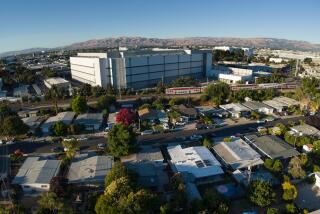Flywheels May Help Keep Grid Running
- Share via
SAN RAMON, Calif. — Whirling flywheels, based on the same mechanism that powered pottery wheels in ancient times and run the latest self-winding wristwatches, soon could be enlisted in California’s battle to keep its air conditioners humming on even the hottest summer afternoons.
On Tuesday, state energy officials gathered at a Pacific Gas & Electric Co. research facility east of San Francisco to unveil a shipping-container-size array of high-tech flywheels that can store enough electricity to serve about 750 homes. Experts say that could be sufficient to keep the electricity grid running reliably if a momentary surge or shortage were to jolt the system.
“People don’t realize how delicate the grid is,” said Gene Hunt, director of corporate communications for Beacon Power, the Wilmington, Mass., company that has developed the first-of-its-kind flywheel system for storing and recycling electrons. The ability to almost instantaneously convert mechanical flywheel power into electricity could help grid operators avert blackouts by “keeping switches from tripping, circuits from overloading and equipment from being damaged,” he said.
U.S. electricity grids are huge machines in which all of the equipment, operating on alternating current, pulses together at a frequency of 60 hertz, or 60 cycles per second. Grids become unstable if the frequency varies by more than one-half of 1 hertz, Hunt said.
Employing the same principle that keeps a yo-yo turning, Beacon’s flywheel system, dubbed a “megawatt in a box,” uses the grid’s extra electrical energy to spin a series of disks. When the grid needs power, the motors driving the flywheels become mini-generators and the disks gradually spin slower.
Flywheel units eventually could provide California with as much as 3% of its electrical needs and save millions of dollars for utility ratepayers by alleviating the need to contract with generators for expensive standby power, officials from California’s grid operator said. Currently, inefficient and polluting power plants provide last-minute generation to avoid rolling blackouts when problems develop.
Once installed, the flywheels should require little of the costly maintenance required by conventional power plants, Beacon President and Chief Executive Bill Capp said. Unlike chemical batteries, which contain hazardous materials, the flywheels can’t explode and are designed to work continuously for at least 20 years, he said.
The ability to store and release large amounts of electricity -- safely, quickly and cleanly over short periods of time -- could become crucial during the next few years as California increases the amount of power from renewable sources such as wind and solar energy, said Ken Wiseman, chairman of the California Independent System Operator, the nonprofit corporation that operates about 75% of the state’s transmission lines.
Alternative forms of energy, although they don’t pollute, can be unreliable when the wind stops or shifts direction or when clouds block the sun.
“We’ll have more of an imbalance” between supply and demand, and “this is another tool for managing them,” Wiseman said.
Cal-ISO, which is sponsoring the tests of Beacon Power’s flywheels along with the California Energy Commission and the U.S. Department of Energy, is hoping the new technology will be commercially available by early 2007, Wiseman said.
“This is real-world [testing],” he said. “We have to keep the lights on.”
More to Read
Inside the business of entertainment
The Wide Shot brings you news, analysis and insights on everything from streaming wars to production — and what it all means for the future.
You may occasionally receive promotional content from the Los Angeles Times.









